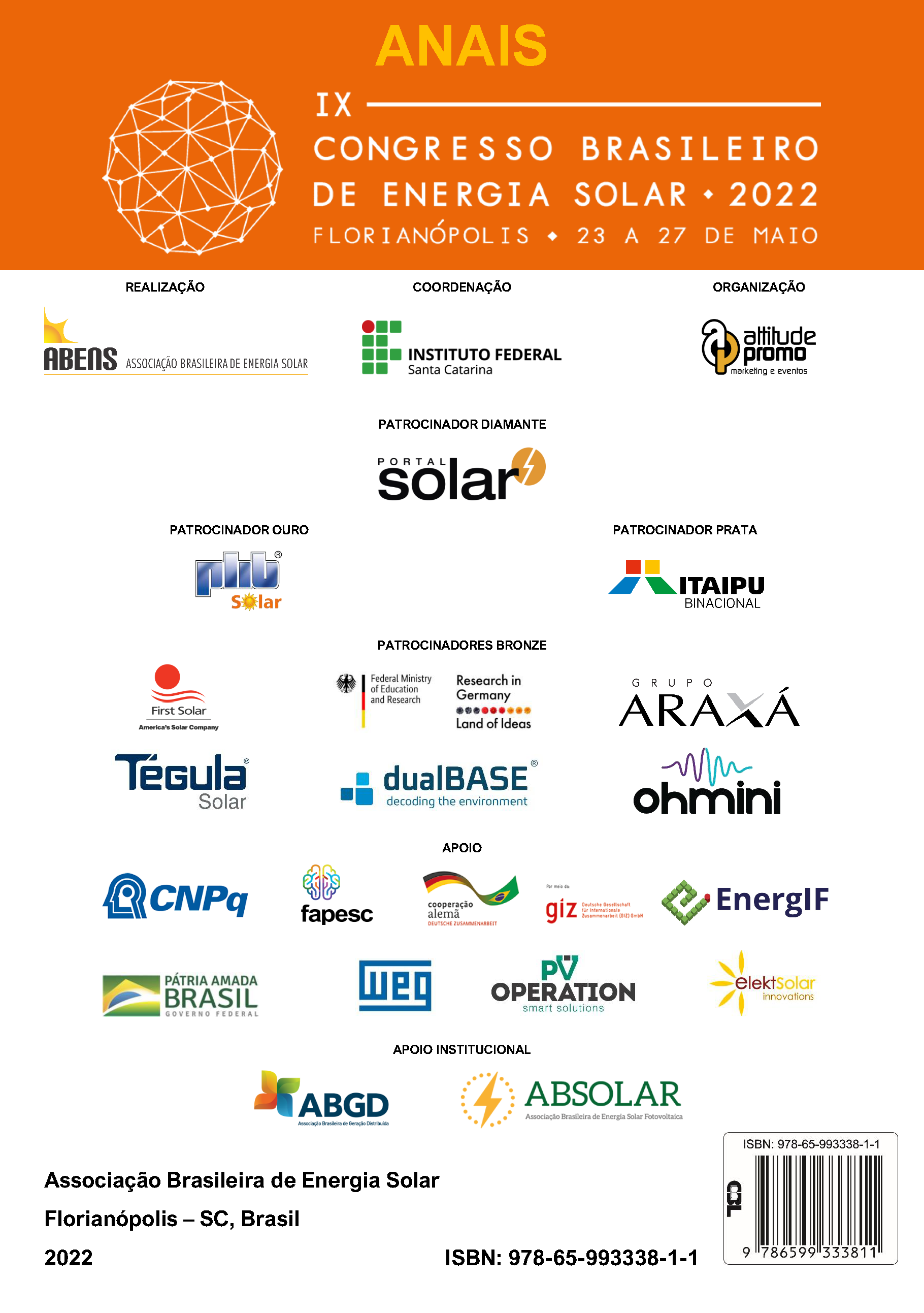BENEFITS TO SOCIETY PROVIDED BY ENERGY EFFICIENCY ACTIONS IN LIGHTING SYSTEMS LIGHTING SYSTEMS AND BY THE AGGREGATION OF PHOTOVOLTAIC MINI-GENERATION TO BUILDING
DOI:
https://doi.org/10.59627/cbens.2022.1158Keywords:
Photovoltaic Energy, Energy Efficiency, CO2 AvoidedAbstract
This work aims to develop a method to evaluate, from the perspective of society, the benefits provided by the insertion of photovoltaic mini-generation and by energy efficiency actions in lighting systems (EESI) in buildings. For a consumer unit (UC) owned by the Federal University of Santa Catarina (UFSC), powered at medium voltage, located on the Trindade Campus of the UFSC, in addition to energy efficiency measures in lighting systems, a 711 kWp mini solar PV system was designed. In the analyzed period, the results showed that the projected PV system would generate annually approximately 908 MWh, equivalent to approximately 54% of the annual electricity consumption of the UC during offpeak hours. An energy efficiency project for lighting systems in the buildings integrating the UC was carried out. The results showed that the replacement of fluorescent lamps (current system) with LED lamps (proposed system) would provide a reduction in demand at peak hour RRP of 307.2 (kW), annual electricity savings of approximately 818.1 MWh, annual cost avoided by the electrical system due to the RRP of R$ 192,617.47 and annual cost avoided due to the energy saved of R$ 361,248.42. The replacement of the lamps of the internal lighting systems of the buildings integrating the UC CDS Piscinas of UFSC (current system) by LED lamps (proposed system) would provide the electrical sector with an annual benefit of R$ 553,865.89. The total annual avoided cost that would be provided by energy efficiency actions in lighting systems and by the insertion of photovoltaic generation at UC CDS Piscinas da UFSC would be approximately R$ 954,811.45. Additionally, through the insertion of PV generation in the UC and the EESI actions in the buildings belonging to it, approximately 784.09 tCO2 equivalent would no longer be released into the atmosphere (equivalent to the planting of approximately 3,400 trees).
Downloads
References
ANEEL, RESOLUÇÃO HOMOLOGATÓRIA nº 2921, 2021
ALSHUWAIKHAT, H.M., ABUBAKAR, I., 2008. An integrated approach to achieving campus sustainability: assessment of the current campus environmental management practices, Journal of Cleaner Production, vol. 16, pp.17771785.
BNEF, 4Q 2017 Global PV Market Outlook – Booming again. Bloomberg New Energy Finance, 2017. COULSON, K.L. Solar and Terrestrial Radiation. Academic, San Francisco, 1975.
CUSTÓDIO, I., P. 2016. UFSC Solar: ensaios de energia fotovoltaica integrada à arquitetura. TCC, Departamento de Arquitetura e Urbanismo, Universidade Federal de Santa Catarina.
DOE, Photovoltaics, Office of Energy Efficiency and Renewable Energy, U.S. Department of Energy, 2015. DPAE, 2017.
Departamento de Projetos de Arquitetura e Engenharia. Mapas da localização das faturas de energia elétrica.
Disponível em: http://dpae.seoma.ufsc.br/mapas/
EFICIÊNCIA ENERGÉTICA, 2010. PORTAL DAS ENERGIAS RENOVÁVEIS (PER). Disponível em:
http://www.eficiencia-energetica.com/index.html
ENGIE, 2017. Bônus Eficiente – Linha Fotovoltaica (EE032/2016). Disponível em: http://site.celesc.com.br/peecelesc/index.php/2013-06-17-19-13- 35/pesquisa-por-municipio/181-bonus-eficiente-linhafotovoltaica
KALKAN, N., BERCIN, K., CANGUL, O., MORALES, M.G., SALEEM, M.M.K.M., MARJI, I. METAXA, A., TSIGKOGIANNI, E., 2011. A renewable energy solution for Highfield Campus of University of Southampton, Renewable and Sustainable Energy Reviews, vol.15, pp. 2940-2959.
KOLOKOTSA, D., GOBAKIS, K., PAPANTONIOU, S., GEORGATOU, C., KAMPELIS, N., KALAITZAKIS, K., VASILAKOPOULOU, K., SANTAMOURIS, M., 2016. Development of a web based energy management system for University Campuses: The CAMP-IT platform. Energy and Buildings, vol. 123, pp. 119-135.
NASPOLINI, H.F., BOING NETO, J., PINTO, G.X.A., RÜTHER, R., 2016, Estimativa da produção energética e de desempenho de um sistema fotovoltaico integrado ao complexo aquático da Universidade Federal de Santa Catarina. VI Congresso Brasileiro de Energia Solar, Belo Horizonte.
NASPOLINI, H.F., CAMARGO, C.C.B., ZACCHI, D.R.P., GARBELOTTO, L.A., GOLFETTO, R.M., 2007.
Eficiência energética em estabelecimentos escolares: Escola + Clara, II Congresso Brasileiro de Energia Solar, Vitória.
NASA. Surface meteorology and Solar Energy Release Data Set. Disponível em: http://eosweb.larc.nasa.gov/sse Acesso em: 09/11/19.
PINTO, G.X.A., NASPOLINI, H.F., RÜTHER, R., 2016, Impactos sobre a demanda e contribuição energética da geração fotovoltaica conectada à rede elétrica. VI Congresso Brasileiro de Energia Solar, Belo Horizonte.
Programa de Eficiência Energética, ANEEL. Disponível em: https://www.aneel.gov.br/programaeficienciaenergetica 61
PV MAGAZINE. 2017. PV Magazine. Disponível em: https://www.pv-magazine.com/2017/08/07/chinainstalled-24-4-gw-ofsolar-in-first-halfof-2017-shows-official-nea-data
RÜTHER, R., ZILLES, R., 2011. Making the case for gridconnected photovoltaics in Brazil, Energy Policy, vol. 39, pp. 1027- 1030.
SHRIMALI, G., TRIVEDI, S., SRINIVASAN, S., GOEL, S., NELSON, D., 2016. Cost-effective policies for reaching India’s, 2022, renewable targets, Renewable Energy, vol. 93, pp. 255-268.
WORLD ENERY COUNCIL, 2016. World Energy Scenarios, ISBN: 978 0 946121 57 1. Disponível em: www.worldenergy.org


